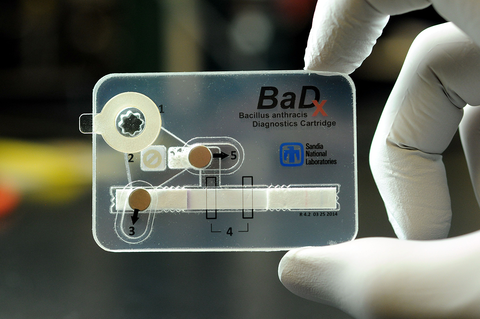
Featured in the Fiscal Year 2014 Federal Laboratory Technology Transfer report released by NIST, this pocket-sized device for detecting anthrax bacteria is based on technology developed at Sandia National Laboratories and licensed to a New Mexico firm.
The National Institute of Standards and Technology (NIST) has released the Federal Laboratory Technology Transfer, Fiscal Year 2014, Summary Report to the President and Congress. Including both quantitative and qualitative measures of effectiveness, the report provides the most current comprehensive view of federal technology transfer efforts across 11 agencies.
As detailed in the report, federal laboratories entered into more than 9,180 formal collaborative research agreements and 27,182 other collaborative research and development-related relationships in FY 2014. Federal researchers made 5,103 new invention disclosures, filed 2,609 patent applications, received 1,931 patents, and generated more than $194.2 million in income from 5,985 active income-bearing licenses.
Examples of technologies successfully transferred in FY 2014 include:
- the world’s first 3-D endoscope providing surgeons with a visually more comprehensive understanding of the tight working space within the human skull;
- chip-scale atomic magnetometers that can be used to detect concealed weapons, locate underwater pipes and cables and medically image the heart and brain;
- a modular positron emission tomography (PET) detector to use in clinical oncology for staging various cancers, assessing treatment strategies and monitoring the effects of therapies;
- a bacillus anthracis diagnostic device that provides enhanced sensitivity with no requirement for batteries or electric power to operate and can be used in parts of the world where anthrax is prevalent, but refrigeration and lab facilities are lacking; and
- new food defense modeling and simulation capabilities that provide industry and the federal government with new tools to support the Food Safety Modernization Act.
“Technology transfer” is a legal mechanism by which federally funded research results are transferred to the private sector so that they may be further developed into consumer products and services. Technology transfer statutes also allow academic and industry researchers to use federal laboratory facilities and enable research partnerships between federal laboratories and nonfederal institutions and businesses.
On Oct. 28, 2011, President Obama cited the importance of invention and technological innovation as drivers of economic growth in a memorandum and directed federal laboratories to accelerate technology transfer operations over the next five years. In addition, the memorandum directed the Secretary of Commerce to improve and expand, where appropriate, the collection of metrics regarding the effectiveness of federal technology transfer activities. This initiative is a key element of the President’s Management Agenda, which also includes the Lab-to-Market initiative, a strategy to accelerate and improve the transfer of new technologies from the laboratory to the commercial marketplace.
In response to these initiatives, agencies have established new performance goals, metrics and evaluation methods to enhance the efficiency and impact of their technology transfer activities. These activities include ongoing efforts to partner with U.S. industry; academic institutions; nonprofit foundations; and state, local and tribal governments. This report serves as a measure of progress toward meeting the ambitious goals of the President while maintaining excellence in performing mission-focused research.
This and reports from past years are available on the NIST Technology Partnership Office’s website.

